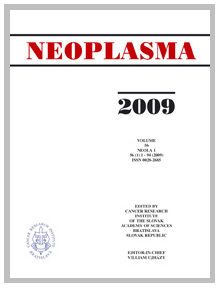Journal info
|
||
Select Journal
Journals
Bratislava Medical Journal Ekologia - Ecology Endocrine Regulations General Physiology and Biophysics Neoplasma 2025 Ahead of print 2024 2023 2022 2021 2020 2019 2018 2016 2017 2015 2014 2013 2012 2011 2010 2009 2008 2007 2006 2005 2004 2003 Acta Virologica Studia Psychologica Cardiology Letters Psychológia a patopsych. dieťaťa Kovove Materialy-Metallic Materials Slovenská hudba 2025Webshop Cart
Your Cart is currently empty.
Info: Your browser does not accept cookies. To put products into your cart and purchase them you need to enable cookies.
Neoplasma Vol.67, No.6, p.1424–1430, 2020 |
||
| Title: Insights from the Greek experience of the use of Blinatumomab in pediatric relapsed and refractory acute lymphoblastic leukemia patients | ||
| Author: Μ. ΑMPATZIDOU, A. KATTAMIS, M. BAKA, G. PATERAKIS, T. ANASTASIOU, M. TZANOUDAKI, A. KAISARI, G. AVGERINOU, D. DOGANIS, V. PAPADAKIS, V. KITRA, S. POLYCHRONOPOULOU | ||
| Abstract: Pediatric refractory or relapsed acute lymphoblastic leukemia (ALL) poses unique therapeutic challenges, with novel immunotherapy approaches offering potential cure opportunities. In this frame, the use of Blinatumomab may induce durable remissions, serving as a successful bridge to allergenic hematopoietic stem cell transplantation (allo-HSCT). Herein, we retrospectively summarize the Greek experience on pediatric relapsed/refractory B-cell precursor ALL patients that were treated with Blinatumomab in a compassionate, off-label setting as an effort to achieve disease clearance and proceed to allo-HSCT. In our cohort of 9 patients, 6/9 (66.7%) responded to Blinatumomab, achieving complete morphological remission (CR) after the 1st cycle, while minimal/measurable residual disease (MRD)-negativity (=2-log reduction of MRD value before and after Blinatumomab administration), was associated with a median RFS/OS of 7.4/7.6 months, while lack of MRD response was associated with a median RFS/OS of 0.5/3.0 months, respectively. Novel therapeutic maneuvers, in order to overcome disease resistance, i.e. increased usage of Blinatumomab dose (45 μg/m2/day), combination with donor lymphocyte infusions (DLIs), use of other immunotherapy salvage approaches (inotuzumabozogamicin), are herein discussed. Additionally, the optimal number of Blinatumomab cycles, the CD19-negative relapses and lineage switch, are also addressed. Our data although referred to a limited however refractory or relapsed and heavily pretreated number of patients, strongly suggest that Blinatumomab may well induce sustained remissions and serve as an effective bridge to HSCT. Whether immunotherapy combined with chemotherapy can outweigh the need for subsequent allo-HSCT, if incorporated into frontline high-risk ALL therapy, remains an optimistic issue to be verified in future randomized clinical trials. |
||
| Keywords: blinatumomab; refractory or relapsed acute lymphoblastic leukemia (ALL); HSCT; immunotherapy | ||
| Published online: 23-Jul-2020 | ||
| Year: 2020, Volume: 67, Issue: 6 | Page From: 1424, Page To: 1430 | |
| doi:10.4149/neo_2020_200128N93 |
||
|
|
 download file download file |
|

